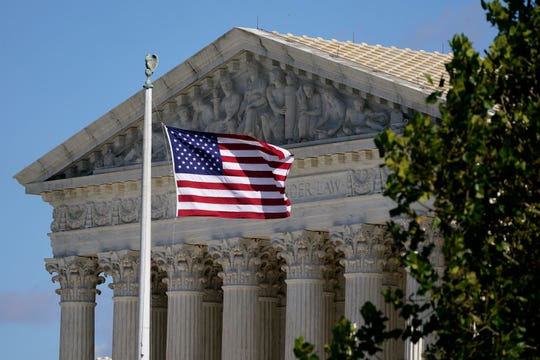Lower courts take notice: The Supreme Court is rethinking qualified immunity
Last week, the U.S. Supreme Court provided the most recent signal that it’s rethinking the doctrine of qualified immunity — a rule the Court created in 1982 to shield government workers from constitutional accountability. The case, McCoy v. Alamu, was filed by a Texas prisoner named Prince McCoy. Four years ago, a prison guard pepper-sprayed McCoy for no reason. The officer was agitated with another prisoner, who had twice thrown water at him. But because this other prisoner was out of reach, the guard took it out on McCoy, an innocent — and asthmatic — inmate. Video taken after the incident shows McCoy pacing his cell, unable to breathe.
McCoy sued, but until the Supreme Court intervened, he was denied justice. Courts at all levels had held that because there was not an earlier court case specifically stating that macing an innocent inmate is unlawful, the officer could not be held accountable for his actions.
Qualified immunity is an automatic defense in a civil lawsuit
These decisions are a product of this country’s perverse system of official accountability. Government workers who violate the constitution get to hide behind the doctrine of qualified immunity — in the news a lot because of the George Floyd killing — even if they act in bad faith or when their conduct is obviously wrong.
The doctrine is an automatic defense in a civil lawsuit, unless a plaintiff can show that there has been a case in the U.S. Supreme Court or in a relevant federal appeals court where the precise conduct at issue was held unconstitutional — in McCoy’s case, that it is unconstitutional to pepper-spray an inmate for nor reason, rather than tase or punch him.
The Supreme Court building on Nov. 2, 2020, in Washington, D.C. (Photo: Patrick Semansky/AP)
If this sounds like putting form above substance, that’s because it is. Every reasonable human being, including a child, knows not to hurt people when they pose no threat. Yet both courts were so caught up in the hyper-technical application of the qualified immunity test that they left common sense behind.
And who could blame them? Until recently, the Supreme Court was not giving the courts any room to maneuver. In almost every case it considered on the issue of qualified immunity, the high court sided with the lower courts that shielded government officials from accountability and reversed lower courts that demanded it. To the Supreme Court, hypothetical policy concerns — such as the need to protect officials from being distracted by lawsuits — outweighed the need to provide plaintiffs with a legal remedy. In other words, in its application of qualified immunity, the Court put policy above law.
Trump defense: Forget Giuliani and the impeachment crew. This is how a real Trump defense would look.
But the Supreme Court may now be entering a new dawn on qualified immunity, and judges of all levels should take notice.
Possible reconsideration on qualified immunity
This pattern began last November, with another prisoner abuse case called Taylor v. Riojas. There, an inmate was forced to spend six days in appalling conditions, including in a cell completely covered in feces. The Fifth Circuit predictably granted qualified immunity to the prison guards. After all, there was not an earlier case stating that condemning a prisoner to six days in an unsanitary hell is unconstitutional. But this time the Supreme Court reversed. Despite the lack of a case matching the exact circumstances at issue, the Court held that “any reasonable officer should have realized that Taylor’s conditions of confinement offended the Constitution.” It was obvious.
Then in December, the Supreme Court granted a resounding victory to Muhammad Tanvir, who had previously been told he could not sue FBI agents who retaliated against him for exercising his religion. That case came to the court at a stage that did not yet involve qualified immunity, but the government’s briefing heavily relied on the same arguments it deploys in qualified immunity cases — that for policy reasons courts should not allow damages lawsuits against government workers. Again, the Supreme Court disagreed, stating that Congress is free to engage in policy-making, “but there are no constitutional reasons why we must do so in its stead.”
Former USCP chief: The U.S. Capitol Police did not fail on Jan. 6
Finally, this week, the Court continued the trend with McCoy. Citing Taylor v. Riojas, the Court once again reversed the Fifth Circuit, indicating that what happened to McCoy was obviously wrong and should not be shielded by qualified immunity.
These are still early days in the reconsideration — if not ultimate rejection — of the court-created doctrine of qualified immunity. But at a time when Americans of all philosophical stripes seek greater government accountability, the Supreme Court is stepping up to deliver by reintroducing some common sense to the law. We hope it continues to do so.
Anya Bidwell and Patrick Jaicomo are attorneys at the Institute for Justice, working on IJ’s Project on Immunity and Accountability. Bidwell is IJ’s Elfie Gallun Fellow in Liberty and the Constitution.
You can read diverse opinions from our Board of Contributors and other writers on the Opinion front page, on Twitter @usatodayopinion and in our daily Opinion newsletter. To respond to a column, submit a comment to [email protected].
Source: Read Full Article

